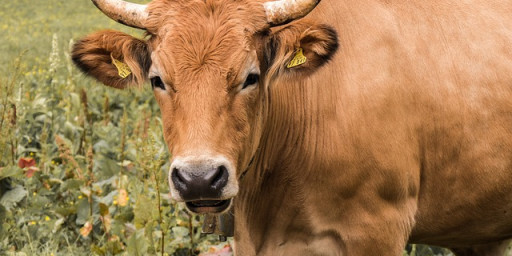1Grazing management
Pasture rotation is one way to help prevent overgrazing, which increases the risk of parasites. Internal parasite eggs are passed in livestock manure and reach an infective stage as quickly as six days later.
If fields are subdivided with temporary fencing and animals rotate into a new area every six days, the animals are out of the old field by the time the parasites reach an infective stage.
Larvae can survive up to 120 days in cool, moist conditions but die much more quickly in hot, dry weather.
Larvae can survive up to 120 days in cool, moist conditions but die much more quickly in hot, dry weather.
Fields can be harvested for hay so that larvae are exposed to and killed by heat and sunlight, or caretakers can plan long rest periods for a field so parasites die before the animals return to that field.
2Multi-species grazing
Not all species share the same parasites. For example, sheep and goats share parasites, but these same parasites cannot survive in cattle and horses.
Graze cattle and horses on the same pasture as sheep and goats, either at the same time or in a leader-follower system, to break the parasite life cycle.
3Sanitization
Keep any stall areas clean to reduce the risk of parasite infestation. Manure should be moved to compost piles or spread on pastures and croplands that are not used for grazing.
4Use feed containers
Feed animals out of containers, like haymangers and feed bunks, instead of on the ground to reduce the risk of parasite infestation. Feeders and water buckets and troughs should be cleaned out regularly to prevent fecal contamination.
5Group animals
Group animals based on how susceptible they are to parasites so they can be treated appropriately. For example, young animals are often more susceptible than adult animals and should be kept on safer pastures.
Animals that have repeatedly had issues with parasites should also be kept on safer pastures, and should ideally be culled or not bred in favor of less susceptible animals.
Animals should not be overstocked in any pastures. Heavily stocked pastures create a higher infestation risk than lightly stocked pastures.
6Deworm
Different animals have different deworming needs. Conducting or having a veterinarian conduct fecal examinations to get a worm egg count is a good way to determine which animals need to be treated. Egg counts before and after deworming can also help determine the effectiveness of a particular dewormer.
Watch for signs of abnormal behavior and appearance and regularly check anemia levels in the mucous membranes of the eyelids, gums or vulva of the animal. If an animal’s mucous membranes are red or red-pink, they are not anemic, but if they are pink, pink-white or white, they are anemic and should be treated for parasites.
Sources: Goat diagnostic methods, extension.org; Dairy goat management, extension.org; Prevent parasites through grazing management, Penn State Extension; Internal parasites in beef and dairy cattle, extension.org; Management and control of internal parasites in horses, extension.org.
(Farm and Dairy is featuring a series of “101” columns throughout the year to help young and beginning farmers master farm living. From finances to management to machinery repair and animal care, farmers do it all.)


